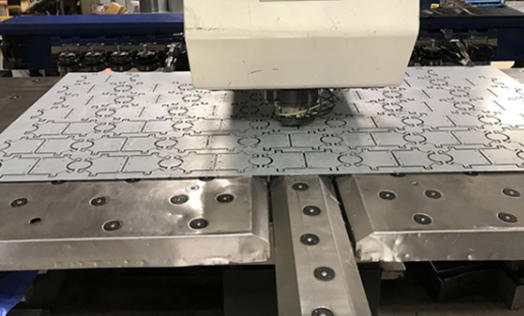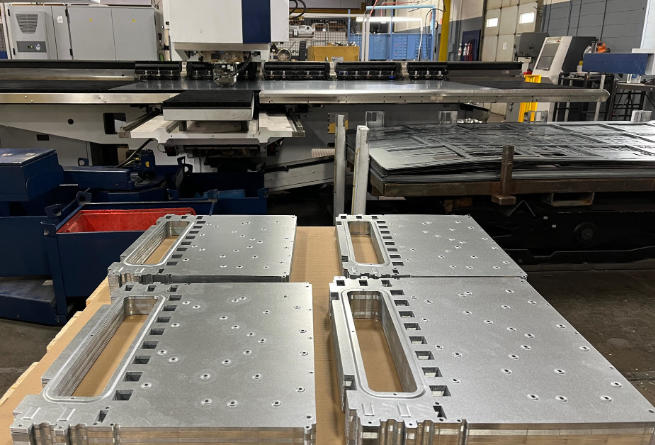Views: 222 Author: Rebecca Publish Time: 2025-11-15 Origin: Site









Content Menu
● Understanding Punch Press Machines
>> Types of Punch Press Machines
● The Fundamentals of Production Efficiency
● Machine Setup and Calibration
● Automation, Robotics, and Material Handling
● Intelligent Software and Digital Process Controls
● Precision, Quality, and Inspection Systems
● Preventive and Predictive Maintenance
● Production Workflow and Lean Layouts
● Workforce Training, Safety, and Culture
● Energy Efficiency and Environmental Sustainability
● Embracing Smart Manufacturing and Industry 4.0
● Frequently Asked Questions (FAQ)
>> 1. How does automation improve punch press efficiency?
>> 2. What maintenance is essential for high-efficiency punch pressing?
>> 3. In what ways can software enhance punch press output?
>> 4. What should a high-performance production layout look like?
>> 5. How can manufacturers achieve sustainable punch press operations?
Efficient punch press machine operations form the backbone of modern manufacturing competitiveness. Achieving higher productivity, reducing costs, and ensuring consistent quality are aspirations shared by all forward-thinking production managers. This comprehensive guide explores actionable strategies, the latest technologies, best practices, workforce development, and sustainability measures that drive tangible gains in punch press production efficiency.

Punch press machines are fundamental in the fabrication of metal components, widely utilized in sectors such as automotive, electronics, HVAC, and consumer goods. They perform high-speed, repetitive tasks—cutting, forming, and perforating metal sheets or coils—with remarkable accuracy and throughput.
- Mechanical Punch Presses: Utilize flywheels powered by electric motors for fast, uniform operations.
- Hydraulic Punch Presses: Employ hydraulic fluid and pistons; offer higher force and more control, ideal for thick or hard materials.
- Servo/Hybrid Presses: Combine precision, speed, and energy efficiency with programmable motion profiles.
- CNC Turret Punch Presses: Automated, digitally controlled presses that enable rapid tool changes and high-mix, low-volume production.
Each type has its unique requirements and strengths, influencing productivity and application suitability.
Production efficiency with punch press machines is measured by the rate of part output per unit time, resource consumption per part, quality consistency, and responsiveness to order changes. Leading manufacturers focus on optimizing these five pillars:
1. Machine setup and calibration
2. Tooling management and innovation
3. Automation and material handling integration
4. Data-driven programming and monitoring
5. Workforce skills and safety
Let's dive deeper into each domain to uncover advanced practices and new solutions.
The journey to higher productivity begins with choosing the right punch press for the job and setting it up meticulously.
- Load Capacity & Stroke: Select a machine that matches your material thicknesses and planned production speeds.
- Press Alignment: Level and align the press to minimize vibration, uneven wear, and part inaccuracies.
- Die-Punch Clearance: Maintain precise clearances to avoid unnecessary tool wear and ensure clean cuts.
- Vibration and Thermal Analysis: Periodically check for signs of structural stress and abnormal heat, indicating parts needing maintenance.
Proper calibration not only yields consistent quality but also prevents unplanned downtime from breakdowns or defective output.
Tooling quality is a principal driver of output speed, longevity, and part accuracy.
- Use High-Grade Tool Steels: Tool steels like D2, SKD11, or carbide-tipped punches offer resilience against wear and high-pressure operations.
- Regular Sharpening & Inspection: Dull or misaligned tools increase strain, risk burrs and defects, and slow down the process.
- Surface Treatments: Apply TiN or TiCN coatings to reduce friction and stickiness, especially for stainless steel or aluminum applications.
- Multitool Adapters: Enable rapid tool changes within a single press, drastically reducing setup time for high-mix projects.
- Proactive Tool Management: Schedule inspections, track tool life with software, and implement predictive maintenance.
Optimal tooling reduces scrap rates, improves cycle times, and extends both tool and machine life.
Automation is a cornerstone of the modern metalworking factory, pivotal in achieving continuous, high-quality output.
- Servo Feeders: Automatically and precisely supply metal sheets or coils, reducing manual positioning errors.
- Robotic Load/Unload Arms: Contain raw material and finished work handling, supporting 24/7 operations with minimal human intervention.
- Automated Tool Changers: Enable fast, program-controlled switching of punches and dies.
- Conveyors and Buffer Tables: Streamline the movement of semi-finished parts between stations, limiting idle machine time.
With automation, manufacturers can increase throughput, reduce injuries, and achieve more stable processes—key to “lights-out” manufacturing and scaling for demand surges.

Digitalization is transforming the efficiency and versatility of punch press lines.
- Nesting Software: Maximizes sheet utilization, minimizes material waste, and auto-generates efficient cutting paths.
- CAD/CAM Integration: Seamlessly translates design files into machine commands, facilitating consistent reproduction and design changes.
- Real-Time Monitoring & IIoT Sensors: Track KPIs such as cycle time, OEE (Overall Equipment Effectiveness), tool wear, and fault conditions.
- Predictive Maintenance Systems: Harness AI or advanced analytics to forecast tool and component replacements before breakdowns occur.
Data-driven process control not only boosts output but minimizes costly trial and error, leading to higher first-pass yield rates and much tighter quality control.
Delivering high-quality parts consistently is essential for keeping rejection rates low and customer satisfaction high.
- In-Die Sensors: Provide real-time feedback on part presence, thickness, and proper ejection, ensuring compliance with design tolerances.
- Vision Inspection Cameras: Instantly detect defects as parts exit the press, facilitating immediate corrections and quality documentation.
- MES Integration: Record all key parameters and traceability data directly into the manufacturing execution system for audits and continuous improvement.
- Closed Feedback Loops: Link machine sensors and quality systems for immediate response to deviations from target metrics.
Precision at every step transforms production efficiency into a sustainable competitive edge.
Regular and intelligent maintenance is vital for maximizing uptime, extending equipment and tooling lifespan, and avoiding expensive emergency repairs.
- Daily and Weekly Inspections: Focus on cleaning, lubrication, bolt tightness, and hydraulic/pneumatic systems.
- Scheduled Major Servicing: Includes replacing worn tools, calibrating sensors and control circuits, and updating software.
- Vibration and Thermal Imaging: Early identification of issues such as bearing wear or heat build-up allows preemptive intervention.
- Digital Maintenance Logs: Track interventions and use analytics to optimize scheduling and resource allocation.
A robust maintenance culture reduces unplanned stoppages and long-term ownership costs, enabling reliable, around-the-clock production.
An efficient factory layout and streamlined workflows are key determinants of total production performance.
- Linear Material Flow: Design paths that move material from receiving through punching, secondary operations, finishing, and shipping with minimal backtracking.
- Proximity of Key Stations: Place loading/unloading, inspection, and storage points near the punch press to weaken bottlenecks.
- Minimized Operator Movement: Ergonomic placement of controls and materials reduces fatigue, accidents, and process waste.
- Buffer Zones: Integrate buffer tables and conveyors to smooth transitions and minimize machine idle time.
A lean, “just-in-time” layout ensures that every step adds value and nothing delays progress.
No efficiency program succeeds without skilled, safety-conscious, and motivated operators.
- Comprehensive Onboarding: Thoroughly train staff on machine use, troubleshooting, maintenance basics, and emergency procedures.
- Continuous Education: Keep teams updated on new machines, software updates, quality management, and industry best practices.
- Accountability and Motivation: Tie performance rewards to KPIs such as throughput, tool life, and quality metrics to foster a culture of pride and excellence.
- Safety Protocols: Enforce PPE, machine guarding, emergency stop procedures, and ergonomic best practices.
Engaged, well-trained teams are more productive, safer, and essential to adapting to technology-driven improvements.
Sustainability isn't just a marketing term—it's a direct contributor to operational profitability and regulatory compliance.
- Retrofitting for Energy Efficiency: Installing variable frequency drives and energy recovery systems cuts power consumption per unit.
- Monitoring Consumption: Use sensors and plant software to track energy use per press and per part, fostering targeted savings.
- Sustainable Lubricants and Fluids: Switch to low-emission hydraulics and biodegradable lubricants where feasible.
- Waste Minimization: High-precision nesting and automation reduce material scrap, supporting zero-waste initiatives.
By reducing energy and material waste, manufacturers also position themselves to meet global trends toward greener supply chains.
Leading factories are harnessing Industry 4.0 and smart manufacturing to unlock the next level of efficiency.
- IoT-Connected Machines: Share data in real time with plant management, maintenance, and quality teams.
- Remote Diagnostics: Allow suppliers and engineers to troubleshoot and upgrade presses without costly site visits.
- AI-Driven Analytics: Predict failures, optimize production scheduling, and reveal hidden bottlenecks or cost drivers.
- Scenario Example: A company operating five 100-ton presses saw downtime drop 38%, output rise 27%, tool longevity boost 45%, and energy per part decline 12% after implementing automated feeds, predictive maintenance, and MES integrations
Embracing digital transformation ensures that efficiency levels remain future-proof and competitive.
Increasing production efficiency with punch press machines requires a balanced, systematic approach that weaves together optimized equipment selection, advanced tooling, automation, robust digital and software controls, empowered operators, sustainable practices, and an open attitude toward change and improvement. By integrating these elements, manufacturers can dramatically raise output, lower costs, deliver top-tier product quality, and thrive in a competitive, dynamic marketplace.

Automation solutions—such as servo feeders, robotic arms, and automated tool changers—greatly reduce cycle times, minimize manual errors, cut labor costs, and ensure machines run at optimal speed around the clock.
Essentials include daily checks for cleanliness, lubrication, hardware integrity, regular sharpening and inspection of tooling, scheduled major servicing, proactive calibration, and leveraging digital logs and analytics for predictive repairs.
Software like nesting programs and CAD/CAM integration automates complex process planning, maximizes material use, enables rapid order changes, and allows real-time tracking and troubleshooting, all of which drive greater productivity.
A lean layout uses linear flow, minimal distance between operations, ergonomic workstations, automated conveyors, and buffer tables to keep materials and products moving smoothly and without waste.
Sustainable practices include adopting energy-saving technologies, tracking and minimizing energy use, using “green” fluids and lubricants, precise nesting to minimize scrap, and maintaining compliance with environmental regulations.
Why The Right Punch Press Machine Is Crucial for High-Quality Tableware Production?
Punch Press Machines: The Backbone of Efficient Cutlery Production
How To Choose Between Manual And Automatic Punch Press Machines?
Best Punch Press Machines for Small And Large-Scale Manufacturers
Top Manufacturers of Punch Press Machines for The Tableware Industry
What Are The Key Benefits of Investing in A Punch Press Machine for Your Factory?
How Punch Press Machines Are Revolutionizing The Cutlery Industry?
The Role of Punch Press Machines in Modern Kitchenware Production Lines
Punch Press Machine Vs. Turret Punch Press: What's The Difference?
